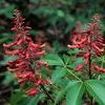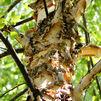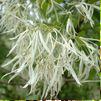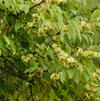Tree Sale - the pictures! Tree photos, descriptions, and more links
|
KCB sells native trees and shrubs in the spring and in the fall The following trees are those we have sold in the past. Go to the page on SHRUBS to see what else we order! |
For more info: Take the Latin name of the tree or shrub and google it. Follow to sites like these: missouribotanicalgarden.org, wildflower.org, arborday.org, wikipedia.org; plants.usda.gov, illinoiswildflowers.info, and the .edu sites.
Plus, we use fknursery.com. Links here are to fknursery and illinois wildflowers. |
Acer saccharum
Sugar Maple ... a large shade tree with excellent form. Famous for its prized syrup, ... fabulous fall color ... grows in a variety of soil types but prefers a rich, well-drained soil. Height: 60-75 feet. www.illinoiswildflowers.info/trees/plants/sugar_maple.htmlIL
Acer saccharum
Sugar Maple ... a large shade tree with excellent form. Famous for its prized syrup, ... fabulous fall color ... grows in a variety of soil types but prefers a rich, well-drained soil. Height: 60-75 feet. www.illinoiswildflowers.info/trees/plants/sugar_maple.htmlIL
Aesculus pavia
Red Buckeye ... is a short tree or shrub* with open habit. Showy red, spring flowers attract ruby-throated hummingbirds. A good accent plant for large shaded areas, esp. when planted in small groves. Height 6-24' Deer resistant.
*Hard to start, so priced like a tree. Asimina triloba
Pawpaw is a multi-stemmed shrub or small tree is a great plant for attracting all kinds of wildlife. Pawpaw's yellowish fruit is relished by many birds and small mammals. Pawpaw spreads slowly to form small colonies or thickets (all one - requiring separate tree for pollination), providing good cover for a variety of wildlife.
Interested in actually getting fruit from your pawpaws? Good luck! According to this site, http://www.petersonpawpaws.com/CulturalAdvice.php, it looks like trees should be 10 to 30 feet apart. Flies are the main pollinator. Another site, https://www.wildflower.org/expert/show.php?id=8990 (scroll down), suggests hand pollinating. With a setting rate (flowers to fruit) of .45 (meaning 1 of 200?!?!) it might be worth it to help mother nature along. Betula nigra
River Birch distinctive bark; good for rain gardens and erosion control -- prefers moist, well-drained soil, but tolerates dry; prefers deep, rich soils, but will grow in clay soils. Grow as single trunk or as a multi-stemmed tree. Height: 40-70 feet. Deer resistant.
 Carpinus caroliniana Carpinus caroliniana
Carpinus caroliniana*
*American Hornbeam* is a handsome small- to medium-sized tree with multiple stems that forms wide, horizontal canopy. Good fall color. Beautiful thin, blue-gray bark is ornamental. Carya illinoinensis

Pecan The largest member of the hickory family (with the sweetest nuts!). Prefers rich, moist soils. Tall straight trunk with symmetrical, broadly oval crown. Height: 70-100 feet. Nut lovers, look at Forrest Keeling's many cultivars and choose.
Carya ovata
Special Orders Only. *Shagbark Hickory* Highly adaptable species for landscape use. The gray to brown bark peels off in thin sections. and golden brown tones. Produces large, edible hickory nuts. A long lived tree. They are considered to produce a lot of 'litter'(bark and nuts) so place accordingly. Height: 60-80 feet. [These trees will come small, but they are hard to find.]
Celtis occidentalis
Special Orders Only. *Hackberry* is a reliable, fast-growing, all-purpose shade tree. Hackberry's pyramidal shape when young then develops a broad crown with ascending branches. The leaves are medium green. Fall foliage is a soft yellow. Birds and wildlife relish the small, fleshy fall fruit.
Cercis canadensis
Redbud native favorite and harbinger of spring that explodes with rosy pink flowers in April. Native Eastern Redbud does well in sun to dappled shade. Adapts to any average garden soil. Height: 20-25. Deer resistant.
Chionanthus virginicus
Fringetree. Shimmering, white fringed flowers cover Fringetree in May or June followed by small, round fall fruit on female trees. leaves often turn bright yellow in fall. Grow in part sun to shade as a small tree or shrub. Beautiful as a single specimen or planted in groups.
Cladastris kentukea/lutea

Yellowwood is an excellent, medium-sized specimen tree, with light green compound leaves turning gold in fall. Spectacular panicles of fragrant, creamy-white spring flowers. Yellowwood bark is very smooth and gray. This is an underused, beautiful native tree.
Cornus alternifolia

Pagoda Dogwood Classic white flowers in spring. Spreading, low-branched tree with horizontal habit and burgundy fall foliage. Good alternative to cold-sensitive Flowering Dogwood. Height: 15-25 feet. Deer resistant.
Cornus florida
Flowering Dogwood Favorite companion to redbuds; understory tree that likes shade, but needs well-drained soil. Provides food and cover for watchable wildlife. Height: 15-30 feet. Deer resistant.
Diospyros virginiana
Persimmon Commonly seen along fencerows, roadsides and field edges, Persimmon is a slow-growing tree that produces small, bell-shaped flowers in spring. After frost, mature persimmon fruits turn orange and taste similar to an apricot. Persimmon fruits are a valuable food source to wildlife.
Fagus grandiflora

American Beech is a large tree, with a dense, oval to round crown and smooth, silvery-gray bark. The leaves are dark green, simple and sparsely-toothed with small teeth. The fruit is a small, sharply-angled nut, borne in pairs in a soft-spined, four-lobed husk. 60-80' Deer resistant.
Gymnocladus dioicus
Kentucky Coffeetree Native shade tree with interesting shape, deeply furrowed bark; adapts to wide variety of sites. Height: 60-80 feet. www.illinoiswildflowers.info/trees/plants/ky_coffee.html
Halesia carolina
Carolina Silverbell is a small native tree with white, bell-shaped spring flowers. Full sun or partial shade.
Juglans nigra *
Special Orders Only.*Black Walnut* Not a great urban tree - it produces litter which stains and juglone which inhibits growth of other plants. BUT it is disease-resistant and makes beautiful wood. The nuts are used in many recipes.
Juniperus virginiana
Eastern Red Cedar is an upright evergreen. Densely pyramidal when young, pendulous with age. Aromatic. Birds enjoy its blue, berry-like summer cones. Drought tolerant. Height: 40-50 feet. Deer resistant.
|
Liriodendron tulipifera
Tulip Poplar - a stately tree. Pyramidal when young, rounded when mature. Leaves turn golden yellow in fall. Tulip-shaped summer flowers followed by interesting fruit. Height: 70-90 feet. Deer resistant.
Magnolia acuminata
Cucumber Tree the largest of the Magnolias, the Cucumber Tree is an excellent shade tree. ... has coarse textured leaves with greenish white fragrant flowers. Height: 50-80 feet.
Magnolia X liliiflora 'Jane'*
Special Orders Only (generally). Not a native! Jane, a broad-rounded shrub magnolia, has reddish purple flowers that are white on the inside and appear before glossy, deciduous foliage. Height: 10-12 feet.
Nyssa sylvatica
Black Gum rivals anything for fall color with spectrum of glowing shades. Fruit is favored by many birds. This is not a sweetgum tree.
This tree has been hard to get lately. We're glad to offer it for sale. Ostrya virginiana *
Special Orders Only. *Eastern Hophornbeam* understory tree with a dense pyramidal shape and attractive bladder-like seed pods. Disease- and pest-resistant. Height: 25-40 feet
Pinus echinata
Shortleaf Pine occurs in dry, sandy or rocky upland areas, but tolerates a wide range of soils. Medium-sized, fast-growing with short pyramidal crown that broadens with age. Migrating butterflies use Shortleaf Pine for roosting. Height: 50-60 feet. Deer resistant.
Platanus occidentalis
Sycamore Thrives on nearly any site; develops a massive trunk with an open wide-spreading crown and has leaves that can grow to nine inches in width. In winter, Sycamore's characteristic large patches of creamy white inner bark are prominent making it a winter landscape standout. Height: 75-100 feet. Deer resistant.
Quercus alba

White Oak a large, majestic, and long-lived oak that holds year long interest. Our state tree in Illinois. Round-lobed leaves and smooth, medium-sized acorns. Height: 45-50 feet; can be as wide as it is tall.
Quercus bicolor
Swamp White Oak is a large tree with broad crown. Leaves turn varied shades in fall from bronze to red.
Quercus imbricaria
Special Orders Only. *Shingle Oak is a medium-size tree (50-60 feet). Its lustrous, laurel-like foliage persists into winter. It is slow-growing but long lived, and provides food and cover for wildlife.
Quercus lyrata
Overcup Oak is a medium size tree (45-60 feet), good for urban environments. Slow-growing but long-lived. Provides food and cover for wildlife.
Image by François André Michaux (book author), Pierre-Joseph Redouté (illustrator), Bessin (engraver) - Histoire des arbres forestiers de l'Amérique septentrionale, considérés principalement sous les rapports de leur usages dans les arts et de leur introduction dans le commerce ... Par F.s André-Michaux. Paris, L. Haussmann,1812-13., Public Domain, https://commons.wikimedia.org/w/index.php?curid=35104746 Quercus macrocarpa
Bur Oak has the largest acorns and leaves of all the oaks. Slow-growing and long-lived, it has a magnificent form in old age. Brown fall foliage persists all winter. Height: 50-60 feet.
Quercus pagodifolia
Cherrybark Oak has lustrous green leaves that turn copper in fall. Great shade tree with larger and better form than other red oaks. Grows on moist sites. Height: 50-60 feet.

Quercus phellos
Willow Oak has foliage shaped like beefy willow leaves that turn yellow to russet red in fall. Typically found in moist bottomland soils but adapts to a wide range of soil conditions including clays with somewhat poor drainage. Generally tolerant of urban pollution. A 2005 Missouri Botanical Garden Plants of Merit winner. Height 30-40 feet Quercus shumardii

Special Orders Only.*Shumard Oak* is a huge, bottomland tree considered the southern counterpart to the Northern Red Oak. In fall, it shows good red color and it one of the first of the season to change.
Quercus texana

Special Orders Only. Nuttall Oak offers richer red fall color, better branching structure, and higher transplant survival than other oaks.
Sassafras albidum

Sassafras In early spring, clusters of small yellow flowers smother the tree. In the summer, fragrant leaves occur in a variety of shapes (even on the same branch). In the fall, Sassafras leaves take on colors ranging from purple to scarlet. BTW - Tea is disrecommended now. Spreads through root sprouts. Height: 30-60 feet. Deer resistant.I
From local nursery: "I have said many times 'the most frustrating plant to cultivate is Sassafras'. Easy to watch grow in every abandoned field & fence row, but MOST difficult to grow in cultivation."said many times "the most frustrating plant to cultivate is Sassafras". Easy to watch grow in every abandoned field & fence row, but MOST difficult to grow in cultivation. [end of quote] Taxodium distichum

Bald Cypress Bald Cypress is a deciduous conifer, with medium-fine, needle-like leave that are soft-textured and light green in summer but turn rusty brown in winter before they drop. Great choice for compacted, urban sites where soil oxygen is low. Height: 50-70 ft.; Full sun; does very well in wet sites. Deer resistant.
Tilia americana

American Basswood (aka Linden) American Basswood (or Linden) is a stately tree with fragrant, yellow, spring flowers. Its high-quality nectar attracts bees and other pollinators. Fall foliage is deep yellow. Height: 60-75 ft. Full sun
|
*I marked with an asterisk (*) those trees which are great trees, but not usually good sellers, so I will order only if I get a request.
